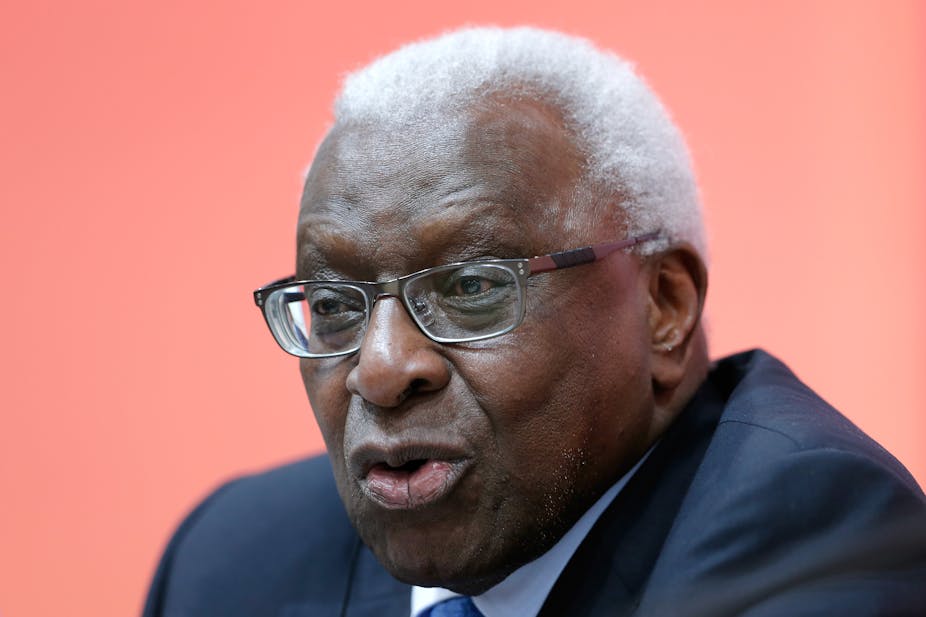Lamine Diack, former president of the International Association of Athletics Federations, died in Dakar, Senegal, on 2 December, aged 88.
He was allowed to return to his home country this year from France after being detained under house arrest for several years.
On 1 November 2015 he was convicted of extorting money from athletes and accused of taking bribes in an Olympic hosting vote.
Although a controversial personality, Africa, a continent in quest of prominent leaders on the international stage, has lost a symbolic figure.
Student and athlete from French empire
Having lost his father at the age of 10 and growing up in modest circumstances, he immersed himself in his studies to nourish great ambitions. He spent his childhood in the cosmopolitan district of Rebeuss in Dakar Plateau.
The elite Van Vollenhoven High School, a non-fee paying school which was a legacy of colonial France, was where everything began for Lamine Diack.
In secondary school, he was among the best students. He excelled in all subjects and in sports, especially football.
Lamine Diack easily obtained his “baccalauréat”. Then he opted for law and economics at the University of Dakar.
The attraction of France and Paris in particular led him to leave Senegal in 1956. He continued his studies at the National School of Taxes (Paris), where he obtained the diploma.
During the 1950s and 1960s in France, athletes from sub-Saharan Africa made their mark on football fields and athletic tracks.
As the 1960 Olympic Games in Rome approached, Lamine Diack was spotted as one of the athletes who could join the French selection, as did another sportsman of Senegalese origin, sprinter Abdou Seye.
The press paid special attention to the “jewels” of the French Empire. Lamine Diack quickly ranked as one of the most promising French athletes of the late 1950s. He was crowned champion of France, confirming his place among the best long jumpers of this period.
In April 1959, at the Afrique Occidentale Française championships in Bangui, he crossed 7.35 metres.
A month later, at the French university championships, he won with a fantastic leap of 7.72m, beating the French record from 1935 (7.70m).
On the eve of the selection of the athletes who would represent France at the Olympic Games in Rome, he injured his knee. He prematurely ended his sporting career and returned to Senegal, where he was destined for a prestigious political career.
From track field to politics
Lamine Diack was among the builders of a new Senegal, freshly independent since August 1960.
He made his entry into politics via sport. He was appointed general secretary of the Senegalese Athletics Federation. At the request of Léopold Sédar Senghor, president of Senegal, he was appointed commissioner-general for sport in 1969.
In 1970, he joined a government team led by Abdou Diouf, who was then a young and brilliant 35-year-old technocrat.
Lamine Diack was called to boost the structural organisation of the sport sector in the country. He was appointed secretary of state for youth and sports and later secretary of state for the prime minister for human promotion, a newly created department.
In 1978, Lamine Diack was elected mayor of Dakar and became a member of parliament. From 1988 to 1993, he was the Vice President of the National Assembly. In the mid-1990s, for personal reasons, he decided to move away from politics.
His interest shifted to the governing bodies of international sport.
International athletics
In August 2001, at the age of 68, Lamine Diack was elected president of the International Athletics Federation with 168 out of 169 votes.
The moment was symbolic. It was the first time a black African leader had presided over such an imposing organisation in the sporting world.
He was the fifth president of the institution, founded in 1912. As president, he moved the International Athletics Federation into the era of globalised sport. According to him, the development of athletics relied on a wide audience and on its ability to become a commercially lucrative product.
For several years, starting in 2010, the press, notably the British, investigated the Athletics Federation on controversial issues: doping, the president’s son’s involvement in the financial activities of the federation and the hosting of the world championships.
Very strong suspicions of illegal practices were pointed out.
Finally, it was Le Monde, the French newspaper, that broke the scandal that affected both the person of Lamine Diack and the structural organisation of the athletics federation.
In an interview with Le Monde in November 2015, Lamine Diack admitted “the unthinkable”. He confirmed his involvement in a corruption case with the Russian state.
He was forced to quit the International Athletics Federation in November 2015 and suspended by the International Olympics Committee. His exit was a disaster for his image and the perception of the African continent.
Lamine Diack symbolised a great hope for a continent previously invisible in the management of global sport institutions. But his image was tainted with corruption, personal ambition, conflict of interest and political pressure.

